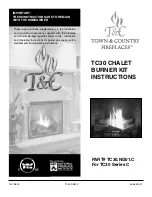
Objects made of combustible materials mst not be placed onto the appliance or in a distance
smaller than the safety distance from the appliance.
4.2 Measures in the event of fire in the chimney
During normal operation, especially if damp fuel is used, soot and tar build up in the chimney. If
the chimney is not regularly checked and cleaned, danger of fire in the chimney will increase.
If this happens, proceed as follows:
do not, under any circumstances, extinguish with water
close all air inlets for combustion, if possible cover up the chimney
contact a chimney service to examine the chimney condition after the fire
contact the manufacturer to check the appliance
If combustible vapours or gases originate, there is a fire or explosion hazard; the stove must be
taken out of service (put out, remove ashes) and proper ventilation must be ensured.
5. First firing
Before and during the first firing leave the stove and ashpan doors slightly open (ca. 1-2 mm) so
that the sealing material does not amalgamate with the varnish. The varnish will harden as late as
after a few hours of firing. Check how the fireclay plates are settled in the combustion chamber
before making the first fire. Keep the temperature rather low during the first firing (feed the fire
more often with smaller amounts of fuel). All materials must adapt to heat development and the
hearth lining will dry slowly. The stove varnish will harden, which will be accompanied by
temporary odour; this odour will later entirely disappear. This provides that no microcracks,
varnish damage or material warping will occur. If the stove is lined with tiles, a fine microcrack
structure will appear on the tiles. This is not a defect; it is a natural accompaniment of heat stress
of the glaze. Sounds ocuring during the heating up or cooling of the stove do not signalize any
defect either.
During the hardening of varnish, sufficient room ventilation must be ensured and pets or birds
must not stay in the room where varnish vapours are present.
5.1 Fire lighting
Insert some crumpled paper into the combustion chamber and put small pieces of wood on it.
Lighting the fire is very easy with a solid firelighter. After lighting, leave the fire to flare up freely
with both the primary and the secondary inlets open. It is prohibited to use flammable liquids (such
as benzine, paraffin oil, etc.) for lighting the fire. As soon as the fire starts to burn and the draught
is sufficient, bigger logs or briquettes can be inserted without fear of excessive smoke. The
combustion air will enter to the fuel from below through the grate. Insert maximum the given
amount of fuel depending on the rated stove output. Fuel consumption is given in the respective
technical data tables. Burning intensity can be regulated by means of the primary air control
elements or by reducing the chimney draught, if there is a smoke flap installed. Bigger amounts of
Summary of Contents for muria
Page 1: ...MANUAL OLYMPIA MURIA...



























